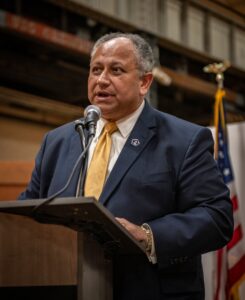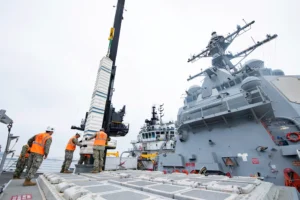The Secretary of the Navy recently announced the creation of a new innovation center and science and technology advisory board to improve department innovation and separately said he intends to focus on rearming ships at sea faster and increasing regional Pacific shipyard capacity.
Speaking at Columbia University on Dec. 8, Secretary Carlos Del Toro said one “enduring priority” the Department of the Navy needs to accelerate is “to drive innovation across every corner of the enterprise.”

He announced several efforts to increase innovation, notably the creation of a Navy Innovation Center at the Naval Postgraduate School in Monterey, Calif.
“This will serve as a premier military education facility tailored to innovation and experimentation, serving as a technology resource for Navy and Marine Corps warfighting development commands, as well as a go-to partner of the defense industrial base, the technology sector, and academia, like here at Columbia,” Del Toro said.
He also said he is standing up a Navy Department Science and Technology Advisory Board that will consist of experts and leaders in their field “to provide independent recommendations on our science and technology portfolio.”
“The best way to deter our adversaries is for the department to restore its technological superiority,” Del Toro said.
The secretary noted this is on top of previous centers of innovation established by the Navy, including Naval X and its 18 Tech Bridges and six Centers for Adaptive Warfighting. He likewise said the Marine Innovation Unit is examining problems like contested logistics, battlespace awareness and the role of small craft in sensing and reconnaissance.
Del Toro also highlighted fleet endurance and resilience as another naval priority he seeks to accelerate during his term.
This is “required to prevail in a high-end maritime conflict of any scope and duration, by ensuring the necessary capability and capacity to Refuel, Rearm, Resupply, Repair and Revive. All while being contested by an able adversary.”
Del Toro said lessons from Russia’s war in Ukraine prove sustainment and logistics requirements are as important as any weapon system, with one example of this he hopes to improve is the ability of Navy ships to rearm vertical launch tubes or vertical launch systems (VLS) at sea.
“During my tenure, we will set the Navy on track to deliver the game-changing capability to rearm our warships at sea. Being able to quickly rearm our warships’ vertical launch tubes at sea will significantly increase forward, persistent combat power with the current force,” he said.
“No longer will our combatants need to withdraw from combat for extended periods to return for vulnerable in-port reloading of weapon systems,” he continued.
Del Toro highlighted a recent demonstration of an at-sea missile reloading in San Diego harbor as an early step in the direction that “paves the way for expedited development.”

In October, the Navy first tested a proof of concept reloading of non-live ordnance vertical launch system via an offshore support vessel platform. The Military Sealift Command (MSC) fleet experimentation ship MV Ocean Valor reloaded the VLS on the Arleigh Burke-class destroyer USS Spruance (DDG-111) to show this can be done pier side or at sea (Defense Daily, Oct. 7).
“My intention is to perfect this capability and field it for sustained, persistent forward-strike capacity during wartime,” he added.
Del Toro also underscored the need to increase the shipbuilding industrial base as another acceleration focus for him, especially to find ways to get combat-damaged ships back to the fight faster.
He noted while the 20-year long Shipyard Infrastructure Optimization Program (SIOP) aims to improve public shipyard capability to complete ship and submarine repair and maintenance on time, a high-end naval conflict with a peer competitor like China requires more, including Pacific region shipyard capacity
“We will need to repair, and even revive, ships at tremendous speed. And we’ll need to do so as close to the fight as possible, so that even damaged ships can return to battle quickly.”
“The intense repair-and-revive demands of a high-end conflict in Asia will require significant shipyard capacity in the Pacific. Accordingly, we are testing our wartime assumptions and looking for opportunities to expand our public shipyard capacity at home and abroad,” Del Toro added.